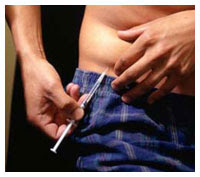
Men with type 2 diabetes who have difficulty achieving an erection could have heart disease and not realize it, according to a report in today's rapid access issue of Circulation: Journal of the American Heart Association.
Men who had silent, or symptomless, coronary artery disease (CAD) and type 2 diabetes were nine times as likely to have erectile dysfunction (ED) as were diabetic men who did not have silent heart disease.
"If our findings are confirmed, erectile dysfunction may become a potential marker to identify diabetic patients to screen for silent CAD," said lead researcher Carmine Gazzaruso, M.D., an internal medicine specialist at Maugeri Foundation Hospital in Pavia, Italy.
Erectile dysfunction and coronary atherosclerosis (narrowing of the coronary arteries) are frequent complications of diabetes, and the association between erectile dysfunction and overt or symptomatic CAD is well documented. However, many diabetic patients have asymptomatic (silent) CAD and are unaware of their heart disease risk. This is the first study to evaluate the prevalence of erectile dysfunction among men with type 2 diabetes and silent heart disease, researchers said.
"Silent CAD is a strong predictor of coronary events and early death, especially in diabetic patients," the investigators noted. "So, it is of interest to know clinical conditions associated with silent CAD to identify subjects who should be screened for CAD."
To evaluate potential associations between ED and silent coronary artery disease, the Italian group studied 133 men who had uncomplicated diabetes and silent coronary artery disease documented by coronary angiography, a test that produces images inside the heart's blood vessels. They were compared with 127 diabetic men who did not have silent heart disease, as verified by a series of tests.
Men in the two groups were evaluated for ED by means of the International Index of Erectile Function (IIEF), a widely used questionnaire to determine a man's ability to achieve erections. The IIEF was administered to all of the men as part of routine ED screening in the year prior to diagnosis or exclusion of silent CAD.
Diabetic men with and without silent CAD did not differ with respect to current forms of treatment. They also had similar rates of diabetic retinopathy, a diabetes complication that correlates with the severity of the disease.
Among the diabetic men with silent CAD, 33.8 percent had ED, compared to 4.7 percent of diabetic men who did not have silent CAD. A statistical analysis that evaluated potential risk factors for silent CAD showed that ED was a better predictor than more traditional risk factors for CAD. Risk factors for silent CAD were apolipoprotein(a) polymorphism (genetic alteration affecting cholesterol), smoking, microalbuminuria (protein loss related to kidney function), and levels of HDL (good) and LDL (bad) cholesterol.
The findings have several potential implications for the evaluation and management of diabetic patients, Gazzaruso said. First, erectile dysfunction warrants consideration with other CAD risk factors, such as high blood pressure and cholesterol abnormalities, in deciding whether a diabetic man requires more extensive evaluation for coronary artery disease.
A second implication relates to treatment of erectile dysfunction in diabetic men. The availability of oral medications for ED has raised questions about their use in men with cardiovascular disease, not only because the drugs can affect blood pressure, but also because they permit formerly impotent men with heart disease to resume sexual activity. Gazzaruso and his associates suggest that diabetic men with erectile dysfunction might require an exercise test or other evaluation for silent CAD before starting erectile dysfunction medication.
As for the possible biologic or physiologic mechanisms that link ED and silent CAD, the investigators cite microalbuminuria and neurologic disorders as possible explanations. However, they emphasize that more studies are needed to determine the precise nature of the association.
Source: Science Daily
According to the American Heart Association, heart disease is the nation's single leading cause of death for both men and women. At least 58.8 million people in this country suffer from some form of heart disease.
And on the whole, cardiovascular diseases (the combination of heart disease and stroke) kill some 950,000 Americans every year.
Still, there are many misconceptions about heart disease: "The biggest misconception is that heart disease only happens to the elderly," said Elizabeth Schilling, CRNP with the Center for Preventive Cardiology Program at the University of Maryland Medical Center.
In fact, according to the American Heart Association, almost 150,00 Americans killed by cardiovascular disease each year are under the age of 65. And one out of every 20 people below the age of 40 has heart disease.
So, it is now a wise decision to keep a constant monitoring of your health. Why to take a chance if we have the option. I was in the similar misconception that heart disease are far away waiting for me to get aged. But to my surprise, I was found to be having a calcium deposit in my coronary arteries. I need to have my advance diagnostic scans due reassure whether something really deadly is waiting for me. Though it was some dreadful going on in my life, but I never felt any kind of discomfort in Elitehealth.com advanced diagnostic facility. They were having some of the latest diagnostic equipments and non invasive techniques which made me feel safe.
Erectile dysfunction is now common disorder but peoples having diabetics can get suffer from erectile dysfunction. But now with the helpful medications it can be cure easily like forzest.